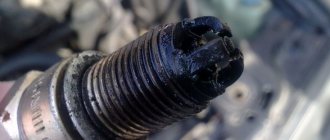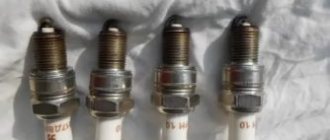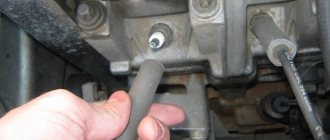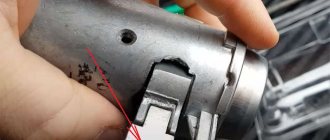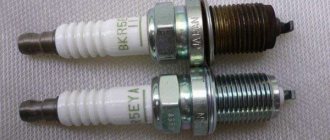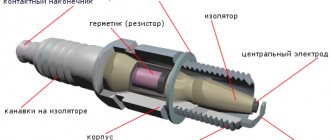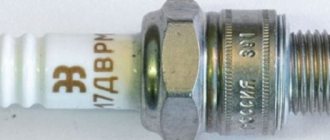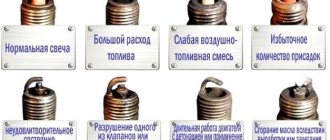During operation, the spark plug of any car is exposed to very high temperatures. In addition, the process of combustion of a mixture of fuel and air causes a chemical reaction, therefore, after intensive use, a coating appears on the working surface of the part, changing its color. A solution to the problem can be the use of candles made of materials that are resistant to both temperature and aggressive chemical influences. In addition, you can simply remove carbon deposits, returning the parts to their previous appearance and original performance.
Black carbon deposits on spark plugs, causes
Black carbon deposits on the electrodes and insulators are one of the most common spark plug problems.
Its appearance indicates certain problems in the operation of the car engine and its systems. In most cases, black soot is the remnants of an over-enriched fuel mixture that have not burned in the combustion chamber. Constant use of spark plugs with black soot leads to interruptions in their operation at best and complete failure at worst.
This is reflected in engine operation by the appearance of dips and jerks, unstable idling (the engine “troits”), “shooting” at the muffler, loss of power and throttle response, and increased fuel consumption.
There are not so many reasons for the appearance of black carbon deposits on the spark plugs of a carburetor engine of a passenger car (for example, VAZ 2108, 2109, 21099, 2105, 2107). Below is a list of them in relation specifically to carburetor engines of VAZ 2108, 2109, 21099, 2105, 2107.
Reasons for the appearance of black carbon deposits on the spark plugs of a carburetor engine
— Reasons related to the carburetor and power system
Black carbon deposits on spark plugs are the result of a highly enriched fuel mixture, the residues from incomplete combustion of which are deposited on the electrodes and insulator of the spark plugs. This can lead to:
Increased fuel level in the carburetor float chamber (“overflow”)
The level is not adjusted correctly, the needle shut-off valve is not sealed, the float(s) are not sealed, the float(s) touches the walls of the float chamber, the fuel pump creates excess pressure (the drive pusher protrudes strongly).
Measuring the fuel level in the float chamber of the carburetor 2108, 21081, 21083 Solex
Measuring the protrusion of the VAZ fuel pump pusher
Wear or leakage of the power mode economizer ball valve
Excess fuel enters the engine not only in power modes, when the economizer should be turned on, but also in all other modes.
Economizer device for power modes of carburetor 2108, 21081, 21083 Solex
Clogged air jets of the main dosing systems
The fuel mixture becomes over-rich because not enough air is supplied to it.
Air jets, fuel jets, emulsion tubes and GDS wells of the Solex carburetor
The fuel mixture “quality” screw is not adjusted correctly
The adjustment was made in the direction of re-enrichment of the fuel mixture.
Screws for adjusting the “quality” and “quantity” of the fuel mixture of the Solex carburetor
The air filter is very dirty
In this case, the balance of fuel and air again shifts towards an excess of fuel.
Heavily contaminated car engine air filter element
— Reasons related to the ignition system
The ignition timing is not set correctly
Most likely the ignition is too early. The fuel mixture ignites too early and does not burn completely.
Ignition alignment mark on flywheel
The high-voltage wires, the cover or the “slider” of the distributor are “broken”
Current leakage through “broken” parts of the ignition system reduces the power of the spark or leads to its termination. The fuel mixture does not burn efficiently.
Ignition coil is faulty
The ignition coil may leak current through a crack in the cover. The consequences are similar to those described above.
The spark plugs themselves are faulty
The glow number of the spark plugs does not correspond to the engine, the gap between the spark plug electrodes is small, the spark plug is internally defective.
The listed malfunctions lead to interruptions in spark formation, a weak spark between the electrodes of the spark plugs and, accordingly, to poor and inefficient combustion of the fuel mixture. As a result, the engine “troubles” or does not start, the electrodes of the spark plugs are black.
— Reasons related to engine malfunction
Severe wear on piston rings
Carburetor VAZ 2107, 2106, 2109, 2110
I would like to dwell in more detail on carburetor cars VAZ 2107, 2106, 2109, 2110, what you should pay attention to first if black spark plugs are found in them.
First of all, pay attention to the “behavior” of the engine, whether it revs or not. If the spark plug is black and dry, then the fault lies in the fuel system, and if it is wet, then in the oil that has penetrated into the combustion chamber. Also, the problem may be in the ignition, which is set incorrectly
If the spark plug is black and dry, then the fault lies in the fuel system, and if it is wet, then in the oil that has penetrated into the combustion chamber. The problem may also be in the ignition, which is set incorrectly
First of all, pay attention to the “behavior” of the engine, whether it revs or not. If the spark plug is black and dry, then the fault lies in the fuel system, and if it is wet, then in the oil that has penetrated into the combustion chamber. The problem may also be in the ignition, which is set incorrectly
The problem may also be in the ignition, which is set incorrectly.
Pay attention to the carburetor, check:
- The second chamber - it must be dry;
- Is the mixture quality screw adjusted correctly?
- How is the fuel level in the float chamber adjusted - if it is incorrect, then as a result of overflow the fuel mixture will become richer and as a result the spark plugs will turn black. The check should be carried out with the carburetor upside down and the top cover removed. The float is located 7-8 mm from the level of the gasket plane. On Solex you can do 10 mm.
- Is the magnetic solenoid valve adjusted correctly?
- How much fuel is in the float chamber? The norm is 2.5 cm from the top edge of the chamber (with the top cover removed) to the surface of the gasoline.
- Check the auto choke. If it is present and faulty, then as a result of a closed damper, an enriched mixture is formed, as a result, the spark plugs are black.
POPULAR WITH READERS: The clutch pedal has failed, reasons and what to do?
You also need to check the condition of the spark plug itself, the high-pressure wire (may break through to ground), and the distributor. Don’t forget about the ignition coil; read how to check it here.
If the engine does not start to stall immediately, but after warming up, then again go through the above points, plus, check the valve adjustment.
Possible reasons for the appearance of soot
Before answering the question of why the candles are black, you need to decide how exactly they turned black . After all, it depends on which direction to search. In particular, the candles can turn black all together, or maybe only one or two of the set. Also, the candle may turn black only on one side, or perhaps along its entire diameter. There are also so-called “wet” and “dry” carbon deposits.
It should be noted that the speed of appearance and nature of carbon deposits directly depends on existing faults (if any):
- Carbon deposits on new spark plugs begin to form after at least 200-300 km. Moreover, it is advisable to drive along the highway at approximately the same speed and engine load. This way the spark plugs will work in optimal mode, and it will be possible to more objectively assess the condition of the car’s components.
- The amount and type of soot depends on the quality of the fuel used. Therefore, try to refuel at trusted gas stations, and not drive with gasoline or similar mixtures. Otherwise, it will be difficult to establish the real cause of the appearance of soot (if it occurs).
- In a carburetor engine, the idle speed must be set correctly.
Now let's move directly to the question of why black soot appears on the spark plugs. There may be 11 main reasons :
- If you notice blackening on only one side, then most likely this is caused by a burnt-out valve. That is, carbon deposits on the spark plug fall on the side electrode from below (and not on the central one).
- The cause of black spark plugs may be a burnt-out valve. The situation is similar to the previous one. Carbon deposits may penetrate the bottom electrode.
- An incorrectly selected glow rating of a spark plug causes not only damage to it during further use, but also uneven blackening at first. If the mentioned number is small, then the shape of the soot cone will change. If it is large, then only the top of the cone will turn black, and the body will be white.
As a rule, when the ignition is set late and the air-fuel mixture is rich, the following consequences arise:
- misfires (error P0300 appears on injection engines);
- problems starting the engine;
- unstable engine operation, especially at idle, and as a result, increased vibration levels.
Next, we will tell you how to eliminate the listed faults and how to clean the spark plugs.
Light electrodes
White or light gray spark plugs in all cylinders are a sign of a lean air-fuel mixture supplied by the injector or carburetor. Moreover, the skirt, area near the electrodes and the threaded part are absolutely dry, without traces of oil.
- lambda - the probe incorrectly informs the control unit about the amount of oxygen in the exhaust gases, the reason is sensor wear;
- faulty or clogged nozzles;
- incorrect carburetor settings or clogged fuel jets;
- insufficient pressure in the injector fuel rail;
- problems with the idle air control;
- air leakage under the manifold or in another place;
- unsuccessful chip tuning of the controller made by the owner of the car.
A lean mixture does not pose any particular danger to a running engine, but it does cause discomfort to the driver. The car accelerates slowly, pulls poorly and jerks - there is a lack of fuel. Oddly enough, the phenomenon causes increased gasoline consumption - a car enthusiast who wants to achieve better performance indicators presses the accelerator pedal harder and more often.
Note. Often the light shade of the working electrodes is explained by the type of fuel used. If the car is operated on methane or liquefied gas (propane-butane mixture), this color is considered normal.
What to do if soot appears
First of all, it is necessary to remember that oil contamination and overheating, which results in soot on the spark plugs, are very harmful to the ignition system . Overheating is especially dangerous, since it causes the possibility of failure of the electrodes on the spark plugs without the possibility of their restoration.
If your car only has one blackened spark plug, you can diagnose the breakdown by simply swapping the spark plugs. If after this the new spark plug also turns black and the old one clears up, it means that the problem is not in the spark plugs, but in the cylinder. And if nothing has changed, then questions arise about the performance of the candle itself.
Oil deposits
In some cases, the candles may be wet and black. Most often, the reason for this fact is oil getting into the combustion chamber. Additional symptoms of this problem are as follows:
- difficulty starting the engine;
- omissions in the operation of the corresponding cylinder;
- the engine jerks during operation;
- the appearance of blue smoke from the exhaust.
Oil can enter the combustion chamber in two ways - from below or from above. In the first case, it enters through the piston rings. And this is a very bad sign, because it often threatens a major engine overhaul . In rare cases, you can get by with decoking the engine. If oil enters the combustion chamber through the top, it comes from the cylinder head along the valve guides. The reason for this is the wear of the valve stem seals. To eliminate this problem, you just need to select new, high-quality caps and replace them.
Carbon deposits on the insulator
In some cases, carbon deposits that naturally appear in the combustion chamber can come off the piston at high engine speeds and stick to the spark plug insulator. The consequence of this will be gaps in the operation of the corresponding cylinder. The engine will “trouble” in this case. This is the most harmless situation why spark plugs turn black. You can eliminate it simply by cleaning their surface or replacing it with new ones.
If black and red spark plugs , this means that you are pouring fuel with an excessive amount of metal additives. It cannot be used for a long time because over time, metal deposits form a conductive coating on the surface of the spark plug insulator. Sparking will deteriorate and the spark plug will soon fail.
Oily texture
In response to the presence of oily deposits, diagnostics of spark plugs based on the appearance of the insulator will issue an expert conclusion - oil is entering the combustion chamber. Electrodes are wet due to lubricant - major repairs cannot be avoided. The situation shown in the photo can happen for three reasons:
- Valve seals are worn out.
- The life of the piston rings is coming to an end.
- The valve guides are broken.
Compression measurements will help separate the culprits. If it is normal, then the problem is related to the tightness of the valves. The following aspect also has the right to life: the thread in the oil is the reason in the cylinder head (with bushings/valve caps). It is possible that lubricant may leak from under the valve cover through the spark plug well.
In parallel with the deposition of oil on the electrodes of the spark plugs, the muffler emits white-blue gases. Another possible symptom is the power plant tripping at the beginning of warm-up.
Cleaning spark plugs from deposits
Cleaning candles must be done regularly, as well as inspecting their condition. It is recommended to do this after approximately 8.10 thousand kilometers . It is very convenient to do this when changing the engine oil. However, if the symptoms described above occur, you can do this earlier.
it is not recommended to use the old method of using sandpaper to clean electrodes . The fact is that this creates a risk of damaging the protective layer on them. This is especially true for iridium spark plugs . Their central electrode is thin and coated with iridium, which is a semi-precious and rare metal.
To clean spark plugs you will need:
- detergent to remove plaque and rust;
- disposable plastic cups (after completion of the cleaning procedure they must be disposed of; they cannot be used for food products in the future);
- a thin brush with hard bristles or a toothbrush;
- rags.
The cleaning procedure is performed according to the following algorithm:
- The cleaning agent is poured into a glass prepared in advance to a level that completely immerses the spark plug electrodes (without an insulator).
- Immerse the candles in the glass and leave for 30-40 minutes (during the process, a chemical cleaning reaction occurs, which can be observed with the naked eye).
- After the specified time has elapsed, the candles are taken out of the glass, and using a brush or toothbrush, plaque is removed from the surface of the candle, especially paying attention to the electrodes.
- Wash the candles in warm running water, removing the chemical composition and dirt from their surface.
- After washing, wipe the candles dry with a rag prepared in advance.
- The final stage is to dry the candles on a radiator, in the oven (at a low temperature of +60...+70°C) or using a hairdryer or fan heater (the main thing is that the remaining water in them completely evaporates).
The procedure must be carried out carefully, cleaning and removing all dirt and plaque present on the surface. Remember that washed and cleaned candles are 10.15% more effective than dirty ones .
Results
The appearance of a black spark plug on a carburetor or injector can be caused by various reasons. As a rule, there are several of them at once . For example, incorrectly selected spark plugs, prolonged engine operation at high speeds, incorrectly set ignition, faulty valve stem seals, and so on. Therefore, we recommend that if the symptoms described above appear, you simply periodically check the condition of the spark plugs on your car.
This way you will not only extend the life of the engine, but also maintain power and driving comfort. You can see additional information on how you can diagnose a car engine by the color of spark plug soot.
Source
Carburetor transition setting
While the engine is idling, the throttle valves are closed. A vacuum (vacuum) is formed under the dampers. Thanks to this vacuum, gasoline is sucked out through a small idle channel and nozzle, and the engine itself runs smoothly at idle. If you open the damper sharply, then the vacuum also weakens. Moreover, this vacuum is not enough for normal operation of the MDS (main dosing system) in the first chamber, and the idle system and accelerator pump are not yet capable of normalizing engine operation. In other words, when you sharply press the gas after idling, there is a delay in the response to pressing the accelerator pedal.
To minimize or completely eliminate this failure, a transition system is used in the carburetor device. This diagram is a hole-slot made above the throttle valve in the first chamber. At the moment you press the gas pedal, the slot-shaped hole appears in a zone of high vacuum, due to which intensive fuel suction occurs parallel to its supply through the idle jet.
Let's go back to the settings. After the carburetor has been installed, many cars experience a failure when starting from a stop, reactions to pressing the gas pedal are slow, and the engine may start shooting at the carburetor or stall. In such a situation, the transition system may be to blame. In order to normalize the operation of the carburetor, it is necessary to correctly select the cross-section of the “spout” of the accelerator pump and the size of the idle jet.
The fact is that it is during operation in the transition mode that fuel comes from both the accelerator pump and the transition system. As a result, the fuel-air mixture may become too rich or, conversely, lean, which does not allow the engine to operate normally and gain speed.
It is important to know that the nozzles in the first chamber do not need to be touched, and the indicated failures should not be attempted to be eliminated by replacing the nozzles of the main dosing system. To solve the problem, use the previously built carburetor to correctly select the idle jet and the accelerator pump nozzle
The selection must be made after the internal combustion engine has warmed up, the choke must be removed.
In practice it looks like this:
The level in the float chamber was previously set and the idle speed was adjusted. A warm engine idles normally without chugging. A stream of gasoline from the accelerator pump nozzle hits the manifold. Now you can sharply press the gas pedal. What is needed is the sharpness of the press, and not how hard the pedal was pressed (to the floor, half a stroke or ¼). Normally, the motor should immediately respond and spin up, that is, the speed increases without delays or failures. If the response to a sharp press on the accelerator is slow or there is a noticeable pause before the speed increases, then you should go to the settings.
To accurately determine the cause, you need to press the gas pedal again, but this time smoothly, not sharply
If in this case there is an even increase in speed (without pauses, dips or delays), then you should pay attention to the idle jet and the pump spout, since the main dosing system has nothing to do with the failure. If, when you gently press the gas, the engine spins up poorly, the unit itself begins to work jerkily, hums, vibrates strongly, etc., then the problem lies in the selection of jets for the first chamber
In other words, excessive enrichment or leanness of the mixture occurs after the carburetor switches to power mode after pressing the accelerator. An indirect sign of a too “rich” mixture during operation in transition mode is that the engine emits black smoke and the smell of gasoline comes from the exhaust system. The specified smoke and smell appear after sharp throttling.
To remove the dip, you must carefully select the idle jets to match the pump spout or vice versa. This is done until the delay disappears when you sharply press the accelerator pedal. In parallel with this, it may be necessary to re-adjust the idle speed, since replacing the XX jet will make changes to the operation of the idle system. Let us add that if the mixture remains lean and there is a dip, and the idle jet is too large and it is not possible to adjust the idle speed, then you can install a paired pump spout, after which both tubes are bent into the first float chamber.
Carburetor VAZ 2107, 2106, 2109, 2110
I would like to dwell in more detail on carburetor cars VAZ 2107, 2106, 2109, 2110, what you should pay attention to first if black spark plugs are found in them. First of all, pay attention to the “behavior” of the engine, whether it is running or not
If the spark plug is black and dry, then the fault lies in the fuel system, and if it is wet, then in the oil that has penetrated into the combustion chamber. The problem may also be in the ignition, which is set incorrectly
First of all, pay attention to the “behavior” of the engine, whether it is running or not. If the spark plug is black and dry, then the fault lies in the fuel system, and if it is wet, then in the oil that has penetrated into the combustion chamber
The problem may also be in the ignition, which is set incorrectly.
Pay attention to the carburetor, check:
- The second chamber - it must be dry;
- Is the mixture quality screw adjusted correctly?
You also need to check the condition of the spark plug itself, the high-pressure wire (may break through to ground), and the distributor. Don’t forget about the ignition coil; how to check it, read here https://autotopik.ru/sovet/997-kak-proverit-katushku-zazhiganiya-multimetrom.html.
If the engine does not start to stall immediately, but after warming up, then again go through the above points, plus, check the valve adjustment.
Church candle: signs about why it can “cry”, fall, smoke and crack
When the candle "cries"
When and how to change spark plugs?
It is believed that a candle “cries” when wax actively rolls down it. This behavior cannot be ignored and here is what the signs say about this:
if the wax began to drain from the candle immediately after it was lit, then this indicates the influence of negative energy from the outside
It is also worth paying attention to the fact that at the moment the person who lit the candle has a very weakened energy background; The weakened energy is also indicated by influxes on the candle. In addition, such a candle indicates that the soul needs peace.
You need to try to protect yourself from unnecessary worries and not engage in self-criticism; if the wax from the candle drips slowly and one drop at a time, then this indicates the presence of a bad person in life. He can be a friend or relative, or just an acquaintance. This person wants to harm the person who lit the candle. You should be careful; a candle on which many influxes are formed, overlapping each other, speaks of an imminent illness. This is a warning from above that you will have to experience all the sorrows of long-term treatment and gain courage to fight the disease; if there are a lot of small sagging on the candle, which are located on one side, but everywhere, then this is an indication of problems in all areas of life. It is recommended not only to take care of your physical condition, but also to pay attention to the moral side of life. Perhaps it is worth reconsidering attitudes towards certain issues, people, and also engaging in spiritual transformation.
When the candle smokes
Candles that smoke with dark smoke can be found quite often. Some people are very frightened by this, and signs indicate the following about this behavior of the candle:
- A candle lit in a temple should not smoke, but if this happens, then this is an indication of the sinfulness of a person. Such people are advised to go to confession and repent, because if this is not done, then various troubles may arise in life;
- If a candle began to smoke in the house, lit on some religious holiday, it is necessary to cleanse the home of negative energy. Perhaps she just gathered in the house due to constant quarrels, or perhaps people with weak energy live in the house;
- when soot occurs as a result of a ritual or prayer, one should speak of the imposed negative. This can be either severe damage or a slight evil eye. In any case, the negative must be removed.
When the candle falls
It is no secret that a candle is placed with the molten tip down, and it is attached to the surface with wax as it hardens, but it also happens that candles fall. Some people immediately begin to panic and say various bad things to themselves. There are many different signs about falling candles and this is what they say:
For unmarried women and girls, a candle falling in a temple promises positive changes in their personal lives. She says that the lady will soon get married; a candle falling in a church for everyone else indicates serious conflicts in the near future
It is necessary to communicate with family and friends with caution. If this is not done, then a quarrel is possible, for which there will be no reconciliation for a long time
It is also recommended to take a closer look at your soul mates. Sometimes a fallen candle signals betrayal; If a candle falls at home, then you should prepare for serious health-related challenges. Perhaps in the near future a serious illness will be discovered in the person who lit the candle.
When the candle cracks
Candle cracking is also a common phenomenon. This behavior of the candle does not mean anything terrible, but the signs indicate the following:
- if the candle begins to crackle immediately after it is lit, then you should expect unpleasant guests. They will be unexpected and bring bad news;
- a candle that does not crackle immediately notifies the homeowners that there is a lot of negativity in the house. It is recommended to invite a clergyman to the house for a cleansing ceremony and go to church for repentance;
- but a crackling sound, similar to hissing, speaks of imminent disappointment. They can relate to any area: work, relationships, everyday life, hobbies, etc. It is recommended to take them calmly and not try to change the situation.
Blue smoke
Smoke of any other color is a sign of a fairly serious breakdown. One sign of damage is the bluish smoke that appears after the engine starts. It can have all shades of color down to dark blue, which will indicate extensive damage to the car's piston system. If bluish smoke comes out of the exhaust pipe, some part of the cylinder has broken. Why is this happening?
Oil must enter the cylinders to lubricate the mechanisms, partially cool them and improve their operating condition. Usually oil cannot get into other components, but if any part of the piston or oil distribution system is damaged, it leaks into the engine chamber. The coolant washes away the oil, taking it with it into the cooling system, where it evaporates into the exhaust channels. Because of this, the smoke gets a bluish color. The color will depend on the intensity of the engine - from transparent blue, almost white to almost blue.
Gas formation of this color is accompanied by strong oil consumption. The solution to the problem is to check the piston lubrication system, valve stem seals or replace the oil with a different brand.
Such smoke in a VAZ-2105 can also appear from the carburetor, not only in the exhaust. This could also be due to the vehicle being idle for a long time or system damage. If the color of the smoke changes over time, then there is no need to worry, the leak goes away after the parts warm up.
FakeHeader
Comments 8
Candles with a whitish coating are a poor mixture, the skirt is black? What can happen to the engine if you drive on a lean mixture? Or is it a little depleted?! Could the lean mixture be due to the ignition?! Or is it just because of the carburetor?! With whitish spark plugs, the engine runs well and the dynamics are good! What should I do or leave it like this?! I read in the manual that when you turn off the engine there should be no shaking, shaking is a late ignition! So it shakes as it is considered when, after turning off the ignition, it wobbles, still continues to work, or just turned it off and the engine staggered when stopped?!
Please tell me, I read it in the manual! Now we connect our light bulb with one wire to the positive terminal of the ignition coil, and the second wire to ground. We remove the central wire of the coil from the distributor cover and fix it at a distance of approximately 1-5 mm from ground. This is done in order to prevent breakdown of the ignition coil to ground. What if you just pull the wire out from there and from there?! Do you have to do it as written?!
Significant wear and depressurization of valve floats
In simple terms, this fuel begins to flow in large quantities into the internal combustion engine of the internal combustion engine in normal and powerful modes.
Clogged air filter
It may also cause darkening of the spark plugs.
It needs to be checked and, if anything, replaced with a new one. Ignition system: the ignition angle is incorrectly set, the insulation of the wires is damaged, the integrity of the cover and the thrombler slider is damaged, then the ignition coil is not working properly and in the end it’s all about the spark plugs themselves.
All of the above reasons can lead to inconsistent sparking, in which case not only gasoline combustion occurs, but also coal-black soot appears on the spark plugs.
Burnt out valves (ICE)
Very often, valves burn out or the gaps are not adjusted correctly.
This also results in carbon deposits on the spark plugs.
A black spark plug corresponds to a reduced compression ratio in the cylinder.
How to fix the above problems?
What to do if black soot appears on the candles.
Firstly, it is necessary for every car connoisseur to remember that oil contamination and excessive heating are all the result of the accumulation of soot on the spark plugs themselves. In this case, it will be very scary if overheating was allowed before. After all, it is precisely because of this that the electrodes on the spark plugs go out of their working condition.
One of the previously installed spark plugs may also begin to leak. And it’s very easy to understand which one exactly caused the wiping; in this case, they should be swapped. And if, after such a simple diagnosis, the new spark plug also darkens, and the old one looks as if it had just come from the store, the malfunction will immediately become clear, then the problem is not in the spark plugs themselves, but in the cylinder.
And if during such a diagnosis nothing has changed, then in such a situation it is necessary to raise the question of the performance of these same candles.
Timing marks
If the camshafts are incorrectly aligned relative to the crankshaft
– the reason for the engine tripping. The opening and closing timing of the intake and exhaust valves will not coincide with the engine strokes.
For example, at TDC of the piston the valve may be closed, so a flash will occur not only in the cylinder, but in the intake or exhaust manifold, depending on which valve is not closed.
This may occur due to a stretched timing drive.
. As the chain or belt is used, it stretches. Therefore, the opening or closing angles may shift. This leads to engine tripping.
Let's go to the device
Components of a car spark plug
- The contact tip is needed to attach the high-voltage armor wire to the spark plug
- The insulator is made of high-strength aluminum oxide ceramics, which can withstand temperatures up to 1000 degrees and electric voltages up to 60,000 Volts
- It is necessary to completely isolate the internal parts of the spark plug (such as the central electrode) from the body
- Actually separates “plus” and “minus”
- The insulator has several annular grooves in the upper part and is coated with a special glaze, which serves to prevent current leakage
- At the end immersed in the combustion chamber, the insulator is made in the shape of a cone, this is called the “heat cone”
- The cone can protrude beyond the body thread (in “hot spark plugs”), and can be recessed into the body (in “cold” spark plugs)
- The spark plug body itself is made of steel, and serves to screw the spark plug into the cylinder head and remove heat from the electrode and insulator
- In addition, it works as a conductor of the “ground” of the machine to the side electrode of the spark plug
- The tip of the central electrode is made of a heat-resistant alloy of iron and nickel, its core is made of copper and another metal (therefore called a bimetallic electrode)
- It serves as a conductor of electric current to create a spark and is the hottest part of the spark plug.
- The side electrode is made of heat-resistant steel containing nickel and manganese impurities
- Some spark plugs have multiple side electrodes to improve sparking
- There are spark plugs with bimetallic side electrodes (iron and copper, for example), which have an increased service life and better thermal conductivity
- The side electrode plays the role of a minus (mass) and is needed to ensure the formation of a spark between the central electrode and it
- Interference suppression resistor made of ceramic
- Basic function of radio interference suppression
- Its connection with the central electrode is sealed with a special sealant
- The resistor is not present in all spark plugs (for example, A17DV does not have a resistor, but A17DVR contains a resistor)
- The O-ring is made of metal
- It is necessary to seal the contact of the spark plug with the seat located in the block head
- The sealing ring is present only on spark plugs that have a flat contact surface
- Spark plugs with a conical contact surface are produced without an o-ring
- The picture above shows a spark plug with a flat surface and an o-ring
Gap between electrodes
The engine of any passenger car operates most efficiently only with a certain gap, which is set between the electrodes of the spark plugs. You should know:
- That the gap in the spark plugs must strictly comply with the conditions of the factory instructions supplied with the car
- If the gap is less than required, the spark that jumps between the electrodes comes out short and weak, this causes the combustion of the fuel mixture to deteriorate greatly, which can lead to carbon deposits on the spark plugs on the VAZ 2109
- If the gap is larger than normal, the voltage required for a spark to break through the air gap that exists between the electrodes of the spark plug increases; the spark may disappear altogether, or it will be too weak
- It is recommended to measure the gap using a special round feeler gauge (note, not flat, as many do) of the required diameter
- If you use a flat feeler gauge, the gap size will be inaccurate
- During the operation of the spark plug, metal is transferred from electrode to electrode
- Therefore, after some time, a pit appears on one electrode, and a tubercle appears on the other electrode.
- This is why only round feeler gauges are suitable for accurately measuring gaps.
- The gaps are adjusted by bending the side electrode
- The gap between the electrodes is adjusted only by bending the “mass” side electrode
- There is no need to look for a specialist here, you can easily do it yourself
- When cold weather sets in, in order to reduce the breakdown voltage, the gap is usually reduced by 1 - 2 tenths of a millimeter
- Then, when you start the engine with the starter in cold weather, it will start faster
Heat number
It is customary to call the heat value of a candle the thermal characteristics of a candle (its ability to withstand overheating). Each type of engine uses a spark plug that has a strictly defined heat rating. Candles are divided into cold ones (having a high heat rating), and accordingly, hot ones (having a low heat rating). Why take into account the heat rating when selecting replacement spark plugs:
- The heat rating depends on the material of the insulator and the size of its lower part (hot spark plugs have a longer part)
- Candles from domestic manufacturers have heat ratings ranging from 11 to 23, and the heat rating of foreign ones is individual for each manufacturer
- If you do not look at this, when replacing spark plugs, then the air-fuel mixture entering the cylinders begins to ignite prematurely, from the hot body, and not from an electric spark
- In this case, the engine begins to “ring” under load (detonation begins, “fingers knock”), as if the ignition timing is set incorrectly
- The engine also continues to run for some time after the ignition is turned off.
- In this case, it is important to change the spark plugs to cooler models.
- And, conversely, constantly appearing black carbon deposits on the electrodes, even if the engine is working properly, indicates an incorrect glow number of the spark plugs
- Correctly selected candles look clean, and the carbon deposits in the lower part are light brown in color, their temperature range is 600-800 degrees
- In this case, the candle cleans itself, and the oil that gets on it immediately burns out, and no carbon deposits form on it
- When the operating temperature is below 600 degrees (as when driving in the city), the spark plug quickly becomes covered with soot; if the temperature exceeds 800 degrees (driving at high speeds), then glow ignition occurs (ignition of the mixture from the hot spark plug body)
- Based on this, we select spark plugs for the engine of our car according to the manufacturer’s recommendations
Malfunctioning spark plugs will certainly lead to problems in the operation of the car engine:
- For example, the appearance of unstable idling (when the engine “troubles”, the speed fluctuates)
- The occurrence of dips, jerks, and twitches, loss of power and throttle response
- Starting is difficult (both cold and hot), all this is a consequence of the use of defective spark plugs
It’s good that it’s not difficult to determine faulty spark plugs even without special equipment. You just need to unscrew them from the engine and carefully inspect them. This procedure is also a diagnostic of the engine, as it shows what is happening inside. Below is a list of the main, constantly occurring faults, among which you can find yours.
Cracks on the insulator
Clearly visible cracks or chips on the spark plug insulator require immediate replacement:
- They appear both at the top of the insulator and inside on the thermal cone located around the central electrode
- The reason for their appearance is either natural wear and tear during long-term use, but more often poor quality of the insulator, as a result of non-compliance with manufacturing technology (initially a noticeable convex longitudinal seam connecting its halves)
- Cracks can appear from detonation arising from an incorrectly adjusted ignition timing, from the use of low-quality fuel (not suitable for the octane number) or a mismatch in the heat value for your engine
- When spark plugs with a cracked insulator are used, current leaks from the spark plug body (its “mass”) and a “breakdown” occurs.
- The strength of the spark discharge jumping between the electrodes decreases, and the spark may disappear altogether
- This results in unstable idling, as well as failures when starting off, loss of power or inability to start.
- To detect microcracks that are invisible to the naked eye, you can detect them by looking at the spark plugs while the engine is running in the dark.
- If discharges are visible flowing around the insulator, this means that it is time to replace the spark plugs
- To prevent the occurrence of cracks in the insulator, it is recommended to replace it in a timely manner.
- The replacement frequency for the VAZ2109 is 15 thousand kilometers.
- Contamination of the insulator is often based on cracks
- In these cracks, soot begins to accumulate, which forms black soot on the spark plug (or on the heat cone located around the main electrode), or red spots appear at the “breakdown” points (from the outside of the insulator)
- The use of such spark plugs has similar consequences for engine operation as described above.
- Normal dirt on the top of the insulator, which does not affect the performance of the spark plug, must be removed by wiping it
Black carbon deposits on the electrodes
On the VAZ 21093, carbon deposits on the spark plugs are black, appearing on the side electrode and on the central electrode, covering the thermal cone of the insulator. The reasons for this are:
- Either their heat rating does not match the engine, so self-cleaning does not occur during operation
- Too rich fuel mixture, due to poor carburetor adjustment or clogged air filter
- The ignition timing may be incorrectly adjusted (ignition is too early)
- Misfire occurs due to “breaking through” of high-voltage wires or insulator
- Incorrect electrode gap
- On the VAZ 2109, the spark plugs are smoked from prolonged idling or prolonged movement of the car in low gears
- The use of spark plugs with black soot impairs engine starting and increases gasoline consumption, reduces engine power, causes unstable idling, and increased smoke from the muffler is observed.
- Having discovered that the spark plugs are black, try driving the car at high speeds for 20-30 kilometers, then unscrew the spark plugs
- If carbon deposits remain, then they should be replaced or the cause determined
Oil on threads and electrodes
The appearance of grease on the spark plugs is often accompanied by black carbon deposits, this indicates a problem with the engine:
- The valve stem seals may have worn out (that’s half the problem)
- The valve guides, or piston rings, the pistons themselves, as well as the cylinders are worn out
- The crankcase ventilation system may become clogged, causing excess oil to enter the combustion chamber.
- If oiling occurs in the upper part of the threads, this means that there is a problem with the valve stem seals, if the lower part and electrodes, then most likely the piston rings are faulty
- Such a malfunction is usually clearly noticeable due to loss of engine power and throttle response, increased fuel and lubricant consumption, difficult starting, unstable idle speed of the engine, as well as smoke from the muffler
- To identify the cause of such a malfunction, it is necessary to measure the compression in the cylinders
- In the best case, clean the crankcase ventilation, or flush the cylinders with an additive to eliminate ring sticking
- At worst - a major overhaul
Fuel on electrodes and threads
Appears when a faulty carburetor “fills” the spark plugs with fuel. Most often, the combustible mixture that enters the cylinders becomes excessively rich due to an incorrectly adjusted gasoline level in the float chamber, or a malfunction associated with the needle valve. Therefore, you should immediately check and adjust the carburetor if necessary, because constant flooding of spark plugs makes it difficult to start the engine.
A white or light gray coating has appeared
When they found light gray or white carbon deposits on the candles in a VAZ 2109, the reasons for its occurrence were as follows:
- Spark plug installed too hot
- It's heat rating is too low and it's simply not suitable for your engine.
- Glow ignition may occur
- Perhaps a poor air-fuel mixture, which results from a poorly adjusted carburetor, or incorrectly installed jets (towards a decrease), an extraneous “suction” of air occurs
- The reason may lie in late ignition, the advance angle is too small
- Continuous driving at high engine speeds
- The above reasons indicate that the engine is operating under abnormal conditions.
- If you do not identify the cause of such deposits and do not eliminate it, then operating the engine in this mode will lead to destruction of the valves, and the cost of repairs will increase
Melting of electrodes
The reason for melting, corrosion and destruction of electrodes is prolonged operation of the motor with constant detonation:
- It occurs due to low-quality gasoline (low octane), due to a mismatch in the heating value (less than necessary), or early ignition
- Starting the engine is difficult, knocking noises are heard, it often overheats, dips or jerks appear when moving, the engine “troubles”
All with possible troubles, the video will help you deal with incomprehensible moments.
Source

